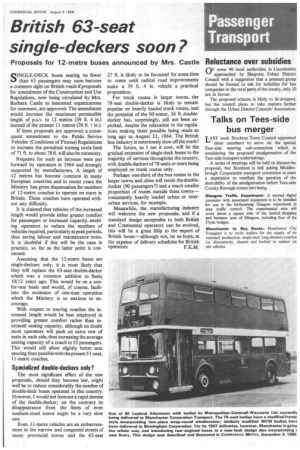British 63-seat single-deckers soon?
Page 31

If you've noticed an error in this article please click here to report it so we can fix it.
Proposals for 12-metre buses announced by Mrs. Castle SINGLE-DECK buses seating no fewer than 63 passengers may soon become a common sight on British roads if proposals for amendment of the Construction and Use Regulations, now being circulated by Mrs. Barbara Castle to interested organizations for comment, are approved. The amendment would increase the maximum permissible length of p.s.v. to 12 metres (39 ft_ 4 in.) instead of the present 11 metres (36 ft. 1 in.).
If these proposals are approved, a consequent amendment to the Public Service Vehicles (Conditions of Fitness) Regulations to increase the permitted turning circle limit of 71 ft. to about 78 ft. will also be necessary.
Requests for such an increase were put forward by operators in 1964 and strongly supported by manufacturers. A length of 12 metres has become common in many European countries and in recent years the Ministry has given dispensation for numbers of 12-metre coaches to operate on tours in Britain. These coaches have operated without any difficulty.
It is claimed that vehicles of the increased length would provide either greater comfort for passengers or increased capacity, enabling operators to reduce the numbers of vehicles required, particularly at peak periods, thus saving labour and maintenance costs. It is 'doubtful if this will be the case in practice, so far as the latter point is concerned.
Assuming that the 12-metre buses are single-deckers only, it is most likely that they will replace the 63-seat double-decker which was a common addition to fleets. 10/12 years ago. This would be on a onefor-one basis and would, of course, facilitate the extension of one-man operation which the Ministry is so anxious to encourage.
With respect to touring coaches the increased length would be best employed in providing greater comfort rather than increased seating capacity, although no doubt most operators will push an extra row of seats in each side, thus increasing the average seating capacity of a coach to 55 passengers. This would still allow slightly better seat spacing than possible with the present 51-seat, 11-metre coaches.
Specialized double-deckers only?
The most significant effect of the new proposals, should they become law, might well be to reduce considerably the number of double-deck buses operated in this country. However, I would not forecast a rapid demise of the double-decker; on the contrary its disappearance from the fleets of even medium-sized towns might be a very slow one.
Even 11-metre vehicles are an embarrassment in the narrow and congested streets of many provincial towns and the 63-seat 27 ft. is likely to be favoured for some time • to come until radical road improvements make a 39 ft. 4 in, vehicle a practical proposition.
For trunk routes in larger towns, the 78-seat double-decker is likely to remain popular on heavily loaded trunk routes, and the potential of the 90-seater, 36 ft. doubledecker has, surprisingly, still not been exploited, despite the relaxation in the regulations making them possible being made as long ago as August 21, 1964. The British bus industry is notoriously slow off the mark!
The future, as I see it now, will be the gradual extension of single-deck buses to the majority of services throughout the country, with double-deckers of 78 seats or more being employed on trunk routes only.
Perhaps one-third of the bus routes in the larger towns and cities will retain the doubledecker (90 passengers?) and a much smaller proportion of routes outside these towns— consistently heavily loaded urban or interurban services, for example.
Meanwhile, the manufacturing industry will welcome the new proposals, and if a standard design acceptable to both British and Continental operators can be evolved, this will be a great fillip to the export of British buses—although not, let us hope, at the expense of delivery schedules for British operators. F.K.M.
















































































































